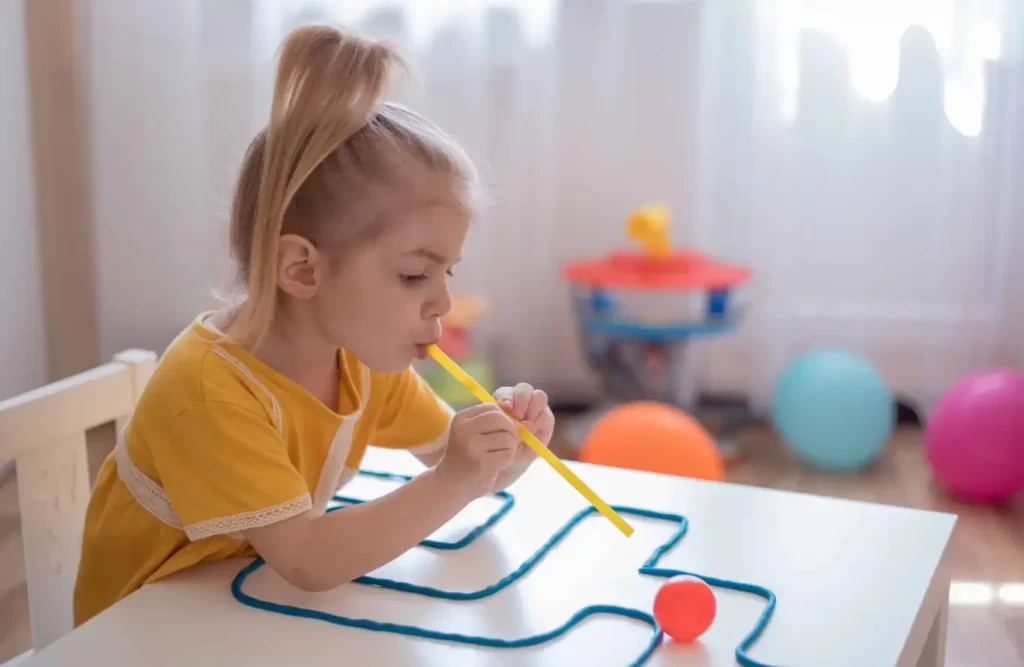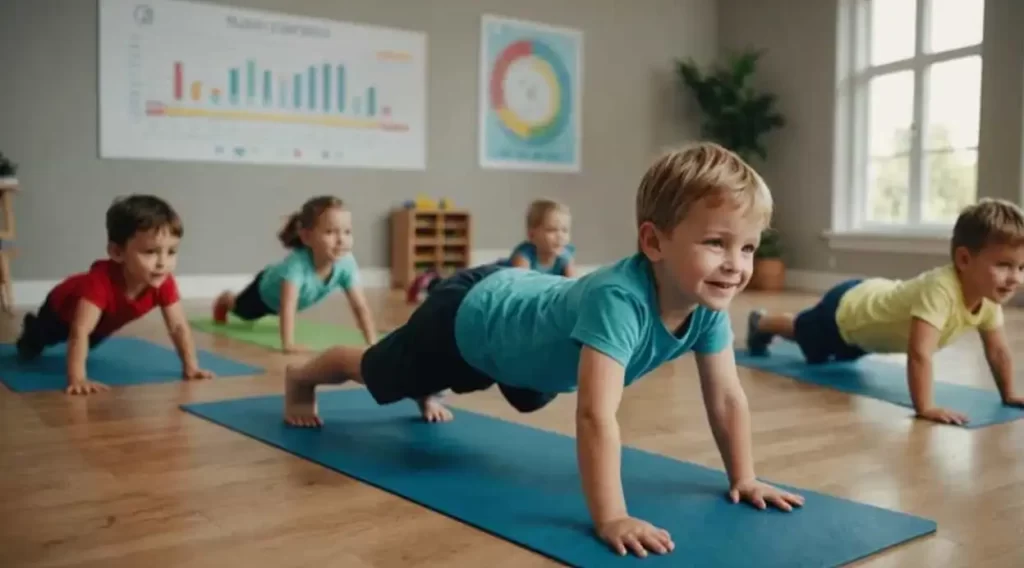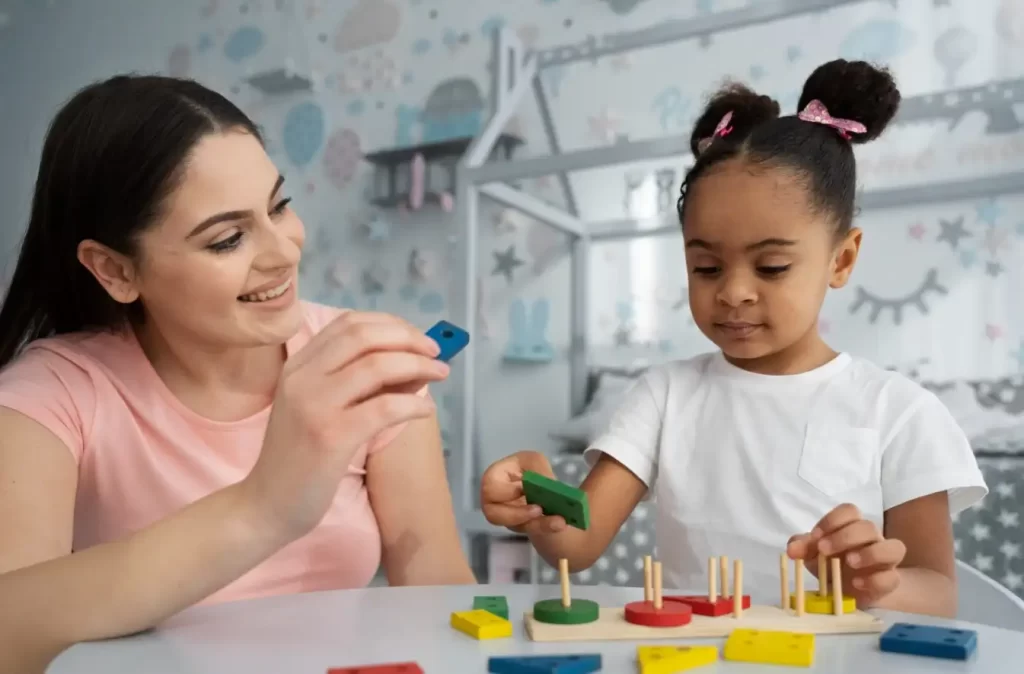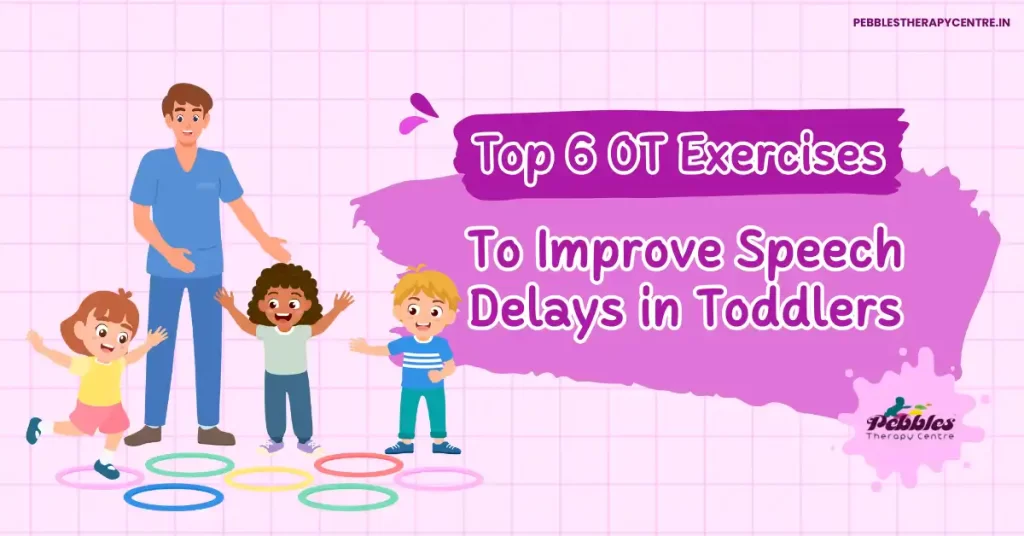Top 6 OT Exercises To Improve Speech Delays in Toddlers
Through speech, children learn to communicate and express themselves, articulate their thoughts, needs, and feelings. Some toddlers, however, take longer to learn these skills, resulting in speech delays in toddlers. This can make interacting with others and learning new things more difficult for them.
The great news is that when we catch early signs of speech delay in toddlers, it can really impact the outcome. Through proper methods, such as speech and occupational therapy, children can develop their communication skills as they grow older.
In this blog, we’ll discuss several common causes of speech delays in toddlers, how occupational therapy for speech delay can provide relief, and six simple speech therapy exercises that encourage young children’s speech and language development.
What is a Speech Delay?
Speech delay occurs in kids whose speech and language skills unfold at a glacial pace. Certain toddlers develop speech patterns slowly under various circumstances but others possibly require specialized speech therapy services.
How Does Speech Delay in Toddlers Work?
Numerous parents ask how common in speech delay in toddlers. Research indicates roughly 10-15% of kids experience speech and language delay somehow. Some kids ultimately catch up by themselves. Others require speech therapy exercises beneath guidance of specialists.
Speech Delay vs Language Delay
✔ Speech Delay – A child struggles with pronouncing and articulating words but understands language well.
✔ Language Delay – The child has difficulty understanding and using words correctly.
If a child shows signs of speech delay, early intervention through speech therapy techniques can prevent long-term communication difficulties.
Common Signs of Speech Delays

Recognizing signs of speech delay in toddlers helps parents seek timely intervention. Here are some speech milestones for toddlers and indicators of a delay:
By 12-18 Months
- Limited babbling or no attempt at words.
- Not responding to their name.
- Preferring gestures over speech.
By 24-36 Months
- Vocabulary of fewer than 50 words.
- Difficulty forming two-word phrases.
- Struggles with articulation and pronunciation.
By 24-36 Months
- A range of fewer than 50 words.
- Trouble putting together two-word phrases.
- Have difficulty articulating and pronouncing words.
Beyond 36 Months
- Trouble following simple instructions.
- Unable to form short sentences.
- Frustration due to communication difficulties.
Consulting with a speech therapist can determine whether speech therapy techniques at home are needed in therapy sessions or at home, if a child lacks these speech milestones for preschoolers.
Possible Causes of Speech Delays in Toddlers
Several reasons for speech delays in toddlers can impact language development:
✔ Hearing Impairments – Difficulty hearing affects speech recognition and reproduction.
✔ Autism Spectrum Disorder (ASD) – Speech delay in toddlers autism is common among children with ASD.
✔ ADHD in Toddlers and Speech Delay – Attention difficulties may hinder language acquisition.
✔ Bilingualism – Speech delay in bilingual toddlers can occur when learning multiple languages simultaneously.
✔ Environmental Factors – Can TV cause speech delays in toddlers? Lots of screen time and little human contact can lead to speech delay reasons in toddlers.
Learning more about what might create speech delays in toddlers allows experts and parents to give toddlers suitable speech therapy activities and help to enhance their communication.
How Occupational Therapy Helps with Speech Development

Parents often ask, “How does occupational therapy help speech?” Whereas Speech therapy services addresses the language and communication half of speech, occupational therapy targets the physical and sensory basis of speech. Talking is not just about putting words together— it requires mouth strength and coordination, breath support, sensory processing, and motor planning.
How Occupational Therapy Encourages Speech and Language Growth
✔ Occupational therapy activities for speech delay help to address the muscles involved in speech production, therefore enhancing diction.
✔ Sensory Integration – Kids suffering from speech and language delay would find it hard to process stimuli and sounds. OT allows them to improve sensory awareness, which in turn supports speech recognition.
✔ Breath Control and Posture – Proper breathing is essential for controlled speech. Speech therapy techniques at home combined with OT exercises like breathing drills improve voice modulation.
✔ Hand-Mouth Coordination – In speech and occupational therapy for autism, you will notice that the activities targeted on developing a child’s capability of imitating mouth movements are some of the most effective in fact that there is.
✔ Social and Cognitive Skills – Speech therapy and occupational therapy for toddlers complement each other to give toddlers numerous opportunities to communicate which greatly improves their confidence and communicative ability.
Combination of speech and occupational therapy at home with professional intervention can lead to the child developing these essential speech and language skills along with improving their speech thus effectively helping them reach their speech milestones.
Top 6 Occupational Therapy Activities for Speech Delay in Toddlers
Engaging toddlers in fun yet structured occupational therapy activities for speech delay can significantly improve their verbal communication. Many speech challenges stem from weak oral motor skills, poor breath control, or delayed sensory processing. These six speech delay exercises target essential developmental areas, helping children with delayed speech or language development strengthen their ability to express themselves.
1. Oral Motor Strengthening Exercises
Speech clearness is greatly affected by oral motor strength. Toddlers find it difficult to say words correctly since speech and language delay result from weak mouth, tongue, and jaw muscles.

Effective Oral Motor Exercises for Speech Delay
✔ Blowing Bubbles – helps in the development of lip and cheek muscles, hence supports pronunciation.
✔ Straw Drinking – Encourages stronger tongue movements essential for clear speech.
✔ Tongue Twisters – Helps improve flexibility and coordination of speech muscles.
✔ Making Funny Faces – Promotes expressive language and increases oral muscle strength.
Speech therapy exercises for toddlers focus on this core activity to help improve speech in toddlers. You can also easily practice these at home besides opting for professional speech therapy services for children. Practicing these at home alongside professional speech therapy services for children can yield positive results.
2. Sensory Play for Speech and Language Development
Sensory activities engage multiple senses, which helps children process speech sounds and improve their speech and language skills. Many toddlers with speech delay in toddlers autism or other sensory challenges struggle with sound differentiation and verbal communication.

Best Sensory Activities for Speech Development
✔ Water Play – Introduces descriptive words like “splash,” “cold,” and “wet.”
✔ Playdough and Texture Boards – Encourages verbal expression through tactile experiences.
✔ Musical Instruments – Improves rhythm, which is crucial for speech pacing.
Integrating sensory activities into speech and occupational therapy at home makes learning speech more interactive and engaging.
3. Hand-to-Mouth Coordination Activities
Children with delayed speech or language development often have difficulty coordinating their hand movements with their mouth in order to imitate speech patterns. This gap is bridged by improving hand to mouth coordination by using speech therapy techniques.

Top Activities for Hand-to-Mouth Coordination
✔ Eating with Finger Foods – This encourages children to look at how the mouth moves while eating.
✔ Mirror Play – Helps them see how their mouth moves when forming words.
✔ Singing Action Songs – Reinforces speech through rhythmic movements.
Encouraging daily practice of these activities within speech and occupational therapy sessions enhances a toddler’s ability to form sounds and words more naturally.
4. Breathing and Core Strengthening Activities
Proper breath control and core strength are essential for voice modulation and speech clarity. Children with speech delay reasons in toddlers often struggle with breath support, leading to weak speech production.

Best Breathing and Core Strength Activities for Speech
✔ Balloon Blowing – Strengthens diaphragm muscles for better speech projection.
✔ Animal Breathing Games – Mimicking animal sounds enhances vocal control.
✔ Yoga for Toddlers – Improves posture, which supports clear speech.
These activities, used in both home-based speech therapy and clinical settings, help develop stronger and clearer speech patterns.
5. Imitation and Gesture-Based Speech Therapy Techniques
Children communicate first through imitation and body language. Encouragement of these attitudes helps to naturally develop speech and language skills.

Effective Imitation & Gesture-Based Techniques
✔ Copying Facial Expressions – Helps with articulation and emotional communication.
✔ Role-Playing Games – Encourages verbal interaction.
✔ Sign Language – Enhances communication skills before verbal speech develops.
These activities are commonly used in speech therapy for autism to support non-verbal communication.
6. Gross Motor Activities for Speech and Language Development
Gross motor movements, such as jumping and swinging, stimulate speech-related brain areas. Many children with speech delay in toddlers treatment benefit from incorporating movement into speech exercises.

Best Gross Motor Activities for Speech Development
✔ Jumping and Clapping to Rhythms – Enhances speech pacing.
✔ Crawling Exercises – Improves posture and breath support for speech clarity.
✔ Swinging While Talking – Encourages verbal engagement.
Integrating gross motor exercises into speech therapy exercises at home makes learning speech more interactive and effective.
These six occupational therapy activities for speech delay support overall speech and language development in toddlers. Whether a child struggles with speech delay in bilingual toddlers, ADHD in toddlers and speech delay, or another communication challenge, targeted speech therapy techniques can help improve their ability to communicate.
Additional Speech Delay Activities for Parents to Try at Home

Professional speech therapy services is helpful and all, but engaging in home-based speech therapy can reinforce the child’s development. But here are some effective yet simple speech delay exercises that can be integrated into the daily routine.
Best Home-Based Speech Therapy Exercises
✔ Reading Aloud Together – This increases vocabulary and develops good listening skills.
✔ Repetition and Modeling – Children learn to try using new words.
✔ Using Visual Cues – Picture books and flashcards help word association.
✔ Encouraging Conversations – Asking open-ended questions promotes verbal responses.
By integrating speech therapy exercises at home, parents can create a language-rich environment that supports speech and language delay recovery.
Early intervention is key and speech therapy and occupational therapy can really help solve the issues of speech delay in toddlers. Utilise the speech therapy techniques at home, through professional speech therapy services and soon you will be hearing your own child chattering away.
However, if you see any signs of speech delay in toddlers, please seek a specialist for their individual therapy plan, I guarantee that they will develop better communication skills and gain the confidence to express themselves using these speech therapy exercises as part of their regimen.
FAQs
Seeking assistance is ideal if your 18-24 month old toddler little talk, has problems understanding words, or has difficulty producing sounds. With speech and occupational therapy, early intervention can be quite effective.
Certainly, speech therapy for toddlers works. The faster pace at which children develop speech and language abilities is aided by the combination of speech therapy techniques and occupational therapy.
Although several infants grow up with speech and occupational therapy at home or expert help, about 10-15 percent of toddlers are affected by speech delays. Early intervention is advised if your child’s speech difficulties persist past age 2.
Yes, ADHD in toddlers and speech delay can be linked. Children with ADHD may have:
- Difficulty focusing on speech cues.
- Delayed speech processing and response times.
- Challenges with memory and word retrieval.
A mix of speech and occupational therapy can help improve speech development in toddlers with ADHD.
Yes, speech delay in bilingual toddlers is common but not a concern unless delays persist beyond age 3. These children often mix languages at first but eventually catch up in both.

